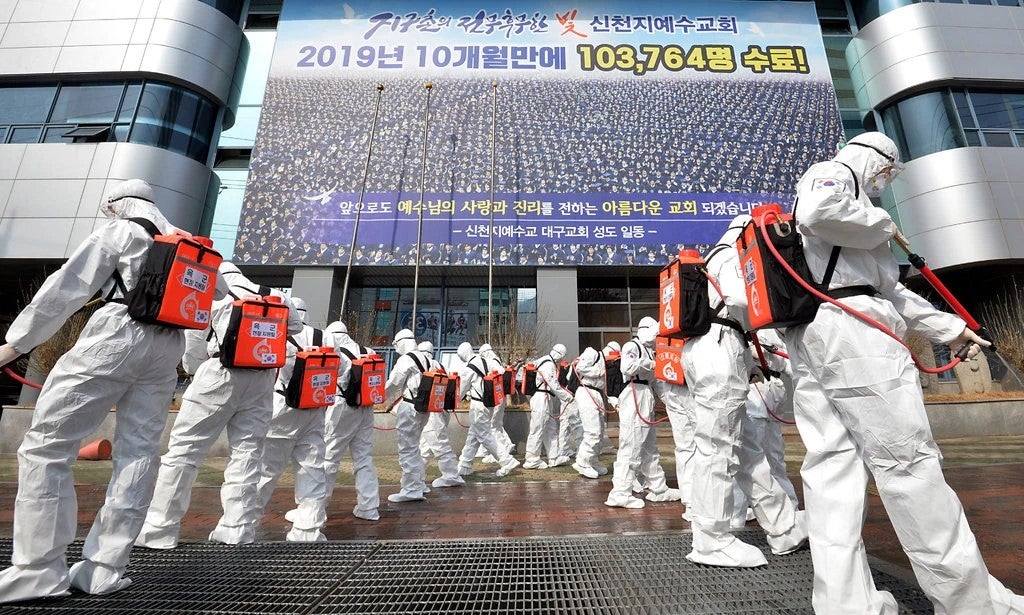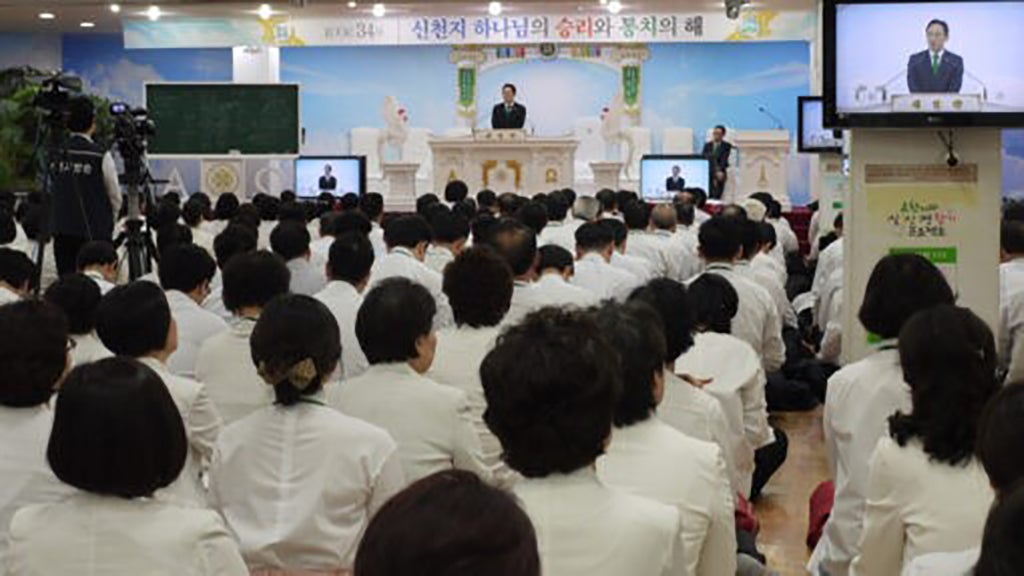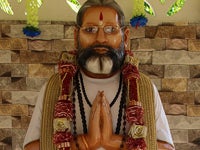Coronavirus, Cults, and Contagion in South Korea
contributed by Heather Mellquist Lehto, 16 October 2020

Cover image credited to Lee Moo-Ryul/Newsis, via Associated Press (retrieved from The New York Times)
Reposted from: Mellquist Lehto, Heather. 2020. “Coronavirus, Cults, and Contagion in South Korea.” Somatosphere, March 21. http://somatosphere.net/forumpost/coronavirus-cults-contagion-south-korea/
All content on Somatosphere is licensed under a creative commons CC BY-NC-SA 3.0 license.
The skin plays a fundamental role in social relations, as captured by the Korean term “skinship.” Our skin helps to define us as individuals, but it is also a threshold (Eliade 1957). It is simultaneously a boundary of our bodies and a medium for communion with anyone—or anything—outside of them (Montagu 1971). Pandemics heighten our attention to our personal boundaries, as we recognize our bodies as less separable from our environment than we often conceive them to be. Unsettling as it may be in the context of COVID-19, whatever you touch, touches you.
By seeking to coordinate how we clean our skin and engage in skin-to-skin contact, public health directives can create forms of social solidarity: “We’re all in this together.” In South Korea, officials anticipated the arrival of a novel coronavirus and began preparations in November 2019. For months, citizens were urged to wash their hands regularly, to report their health using cell phone applications, and to seek testing when symptomatic. Digital surveillance was also critical to their response, and the government tracked the movement of the first infections by monitoring credit card activity and CCTV footage.
After the first several weeks, it seemed as if their preventative measures had helped them avoid an outbreak altogether. In fact, when director Bong Joon-ho triumphantly returned to Korea after winning several international awards for his movie Parasite, he told journalists at the airport in Seoul that he wished to congratulate his country on vanquishing the coronavirus, adding that he would now do the duty of any good Korean citizen: “I will now wash my hands well to join the ranks in overcoming the virus.” In the first few weeks, there were only 30 cases of infection, and the “victory” over COVID-19 appeared certain. President Moon Jae-in was even looking ahead toward economic growth, and he told business community leaders that it appeared domestic quarantine efforts had stabilized the outbreak and the “Corona-19 [sic] soon will end.”
But that all changed two days later, with the now-infamous “Patient 31.” It was reported on February 18th that a 61-year-old woman in Daegu had been diagnosed as infected. Ignoring her elevated fever and sore throat, the week prior to diagnosis she had attended a wedding and a conference, and she refused requests to be tested. She also attended at least two large services at her transnational megachurch, Shincheonji, Church of Jesus, the Temple of the Tabernacle of the Testimony (henceforth Shincheonji). Once “Patient 31” was identified, cases in Daegu spiked, and the number of COVID-19 cases in South Korea rose from 30 to 977 in just eight days. At the time of writing, over half of all COVID-19 cases in South Korea were connected to Shincheonji.

Photograph by Matthew Bell, provided by The World public radio program, theworld.org
Whether or not “Patient 31” was solely responsible for the late February outbreak of COVID-19, she and Shincheonji church have received widespread blame. Shincheonji had occasionally been referred to as a “cult” before the pandemic due to its secretive practices, but now the church was understood to be an imminent threat to the nation and public health. The Daegu congregation was deemed a “cluster,” and the media worked to identify and scrutinize the practices that may have contributed to the rapid spread of infection:
Vector 1: The church uses fingerprint scanners to track attendance. This means that dozens or even hundreds of congregants may have touched the same surface as “Patient 31” when entering church services. This may include a February funeral service for the founding pastor’s brother, at which attendance was mandatory.
Vector 2: Thousands of congregants sit very closely together on the floor during services, sometimes engaging in practices that involve putting their arms around each other’s shoulders.
Vector 3: As an international, multisite church, Shincheonji has dozens of church campuses in China, and many speculated that traveling pastors and congregants had carried the virus transnationally. There are reports that Korean members of Shincheonji had traveled to their Wuhan campus as late as December 2019, after the outbreak in that province had begun.
Identifying these practices served an epidemiological purpose, but they were also offered as evidence of members’ deviance from the ideal modern Korean subject. They defy the corporeal practices of hygienic physical distancing and “personal space.” Moreover, the transnational church threatens the body of the nation, as congregants regularly traverse its protective boundary and may carry pathogens with them. The contagion of the virus was now attributed to its hosts, whose religious ideas and practices have yet to be sufficiently disciplined by the rationality of science and modern medicine. As it was reported in Foreign Policy, “The net effect is that Shincheonji followers infect each other easily, then go on to infect the community at large.”
Resentment toward Shincheonji grew further when the church was uncooperative with public health officials. For example, officials requested a comprehensive list of all 212,000 Shincheonji members in order to trace the paths of infection, but Shincheonji leaders were reluctant to disclose names of members and it took several days for the church to comply. While there may be reasonable privacy concerns one could raise about such requests, in South Korea the church’s hesitance was at odds with broader public health efforts, which have relied upon transparency and a near-total surrender of digital privacy. As one Daegu taxi driver complained to a reporter, “If I violate a traffic law, police contact me before the day is over. How come they can’t get hold of so many cult members? How can we say South Korea is an IT powerhouse with this going on?”
Anxieties about the unseen threat of Shincheonji are layered on top of the anxieties about the virus itself. Especially in Daegu, the specter of Shincheonji has contributed to social distancing. Taxi driver Kwang-ho Lee told a reporter, “Sometimes we’re even too scared to talk to each other because we don’t know who has the virus and who might belong to that cult” Yoon Na, a man in his twenties, says that some young couples had stopped dating, unsure if their partner secretly belonged to Shincheonji and might infect them. “Only couples who know each other very well can be sure,” he told a reporter in early March. When it was discovered that almost a third of an apartment complex in Daegu housed Shincheonji members, the complex’s other residents were shocked. Because so many people were suddenly revealed to belong to Shincheonji, Daegu residents grew increasingly distrustful of even their closest neighbors.
Regulating religious activity and “cults” emerged as a priority for health and safety. Gyeonggi province banned religious activities that don’t conform with virus containment protocols. More than a million people petitioned the government to disband the church, and a barrage of newspaper articles highlighted the threat that not only Shincheonji, but many “cults,” posed to the social order and to South Korea’s reputation as a highly developed nation. News reporters concluded that “Cults and Conservatives Spread Coronavirus in South Korea.” They warned their readers about “Korean Cults: The Missing Link between Coronavirus, Sewol Ferry Disaster, and President Park Geun-hye’s Impeachment.” They analyzed “How Two Korean Cults Measure up against COVID-19.” Seoul City Mayor Park Won-soon offered the most severe rebuke of religious noncompliance when he urged the Chief Prosecutor to investigate Shincheonji pastor Lee Man-hee and twelve other leaders on charges of homicide by willful negligence. Although some churches resisted restrictions on their practices, legal arguments based on the free exercise of religion had limited traction in the context of a global pandemic.
It is worth noting that suspicion of “cult members” and “spies” is not limited to Shincheonji, but pervades other Korean Christian communities as well. During more than two years of field research in several Korean megachurches, I regularly heard Christians label other churches “cults” and share stories and rumors of “cult members” infiltrating their church to spread false theologies or to mislead members to leave their churches and join these “cults.” During the 2015 outbreak of MERS in South Korea there was a similar reappraisal of social relations and modes of physical contact. In some churches, virality was framed both in medical and moral terms, calling many to reflect upon what—beyond disease—could be communicated through social proximity. At Yoido Full Gospel Church (the largest single church in the world), pastor Lee Young-hoon preached in one sermon during the height of the outbreak that “Sin is just like a virus.” Just as Eve spread her sinfulness to Adam, he warned that Christians must be careful about how sin can infect the soul and be communicated interpersonally through prolonged social contact (June 17, 2015).
As anthropologist Mary Douglas’ work (1966) reminds us in moments like these, the difference between religious rites of purification and medical hygiene practices may be no more than a matter of detail. They both can be seen as fundamentally about regulating purity and danger. Perceived tensions between religious and public health prescriptions regarding physical practices bring to light the indeterminacy of corporeal boundaries, our sense of self, and our relations with others. When we are “in touch,” when we commune, what is being shared? How is it being shared? When one touches another’s skin, how deep and indelible is the impression one leaves behind? These anxieties are rooted in a sense of the permeability of the boundaries upon which we rely. In biomedical terms, we are told to guard our eyes, nose, and mouth from exposure to the novel coronavirus, but there are other ways in which we may also feel exposed to other matter out of place, such as false teachings or fake news.
Facing an invisible virus, religious groups—especially those whose practices don’t strictly adhere to public health norms—are treated with heightened suspicion. But the threat of contagion is ambiguously biological and social. To protect ourselves, we revert to defensive postures, and pandemic can become a proxy for skepticism of others. That means not only maintaining the cleanliness of one’s skin, but also, of one’s skinship by identifying what—or who—is with “us” and what must be kept at a distance. The outbreak of COVID-19 has, perhaps unsurprisingly, been accompanied by widespread fascination with seemingly aberrant religious conceptions of health and healing, and the proliferating talk of “cults” classify as pathological and viral the social groups of which one must be wary.
Works Cited
Douglas, Mary. 1966. Purity and Danger: An Analysis of the Concepts of Pollution and Taboo. Routledge.
Eliade, Mircea. 1959. The Sacred and the Profane: The Nature of Religion. Houghton Mifflin Harcourt.
Montagu, Ashley. 1971. Touching: The Significance of the Human Skin. New York: Columbia University.
Heather Mellquist Lehto is an anthropologist and currently a Postdoctoral Fellow at the University of Hawai’i at Manoa. Her work attends to the imbrications of science, technology, secularism, and religion in South Korea and the United States. Her book manuscript, Holy Infrastructure: The Multisite Church Revolution in South Korea and the United States, is an ethnography of the technologies of Christian practice in the first transnational multisite churches in the world.
Disclaimer: The views and opinions expressed in this article are those of the authors and do not necessarily reflect the position of the blog editorial team or the Asia Research Institute.
South Asia | Southeast Asia | East Asia | Other Places | Hinduism | Buddhism | Islam | Christianity | Other Religions



